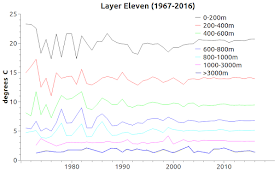 |
| Fig. 1 World Ocean Database |
Today, we look at Layer Six (Fig. 2) and Layer Eleven (Fig. 3).
They are outlined with red lines on the World Ocean Database (WOD) map (Fig. 1).
Each WOD zone rectangle on the WOD map is a 10 degree by 10 degree area, and in terms of latitude and longitude, the WOD zone's location is revealed by the zone number itself, because each one of three sections of the number can be combined to indicate where those zones are geographically located.
 |
| Fig. 2 Layer Six |
Add 10 to the lower latitude number to derive the upper latitude (20N + 10 = 30N), and add 10 to the lesser longitude to derive the larger longitude (30E + 10 = 40E).
So, the complete WOD Zone 1203 rectangle is latitude 20-30N by longitude 30-40E.
 |
| Fig. 3 Layer Eleven |
Anyway, comparing the 6 layers we have looked at so far, the temperatures at various levels show some temperature oscillations that are strong, but most are relatively uniform in appearance in the lower levels.
That can be misleading, if we forget that those temperature changes in the deep water do not happen as a function of the water magically warming (remember the 2nd law of thermodynamics).
Some exterior phenomenon changes the temperature, such as mixing of warmer layers by the dynamic of the 2nd law of thermodynamics (warm flows to cold), currents, hot spots on the ocean bottom (e.g. hot springs, volcanoes), or other forced mixing.
And, to the point of the thermal expansion and contraction series (On Thermal Expansion & Thermal Contraction, 2, 3, 4, 5, 6, 7, 8, 9, 10, 11), these temperature changes cause both expansion and contraction.
Heretofore, the contraction dynamic has been left out of the scientific literature as if there was no such thing.
We are hopefully changing that.
The next post in this series is here, the previous post in this series is here.
No comments:
Post a Comment